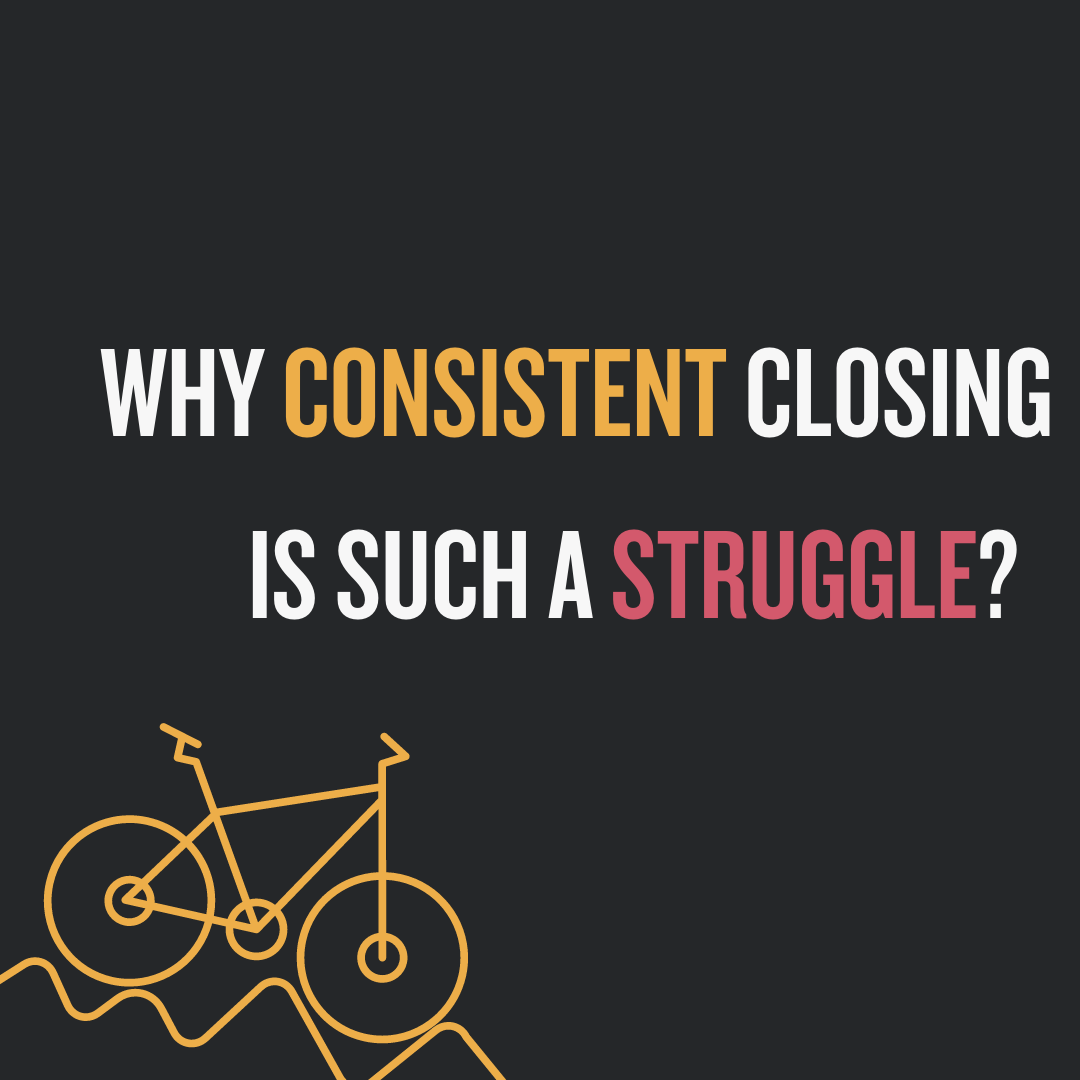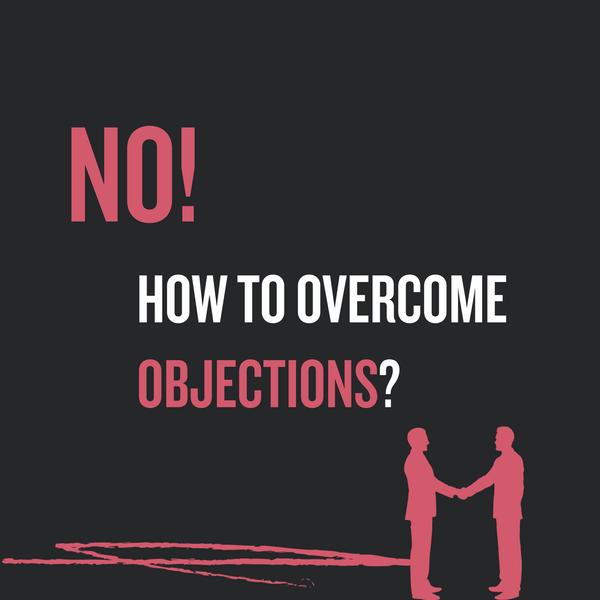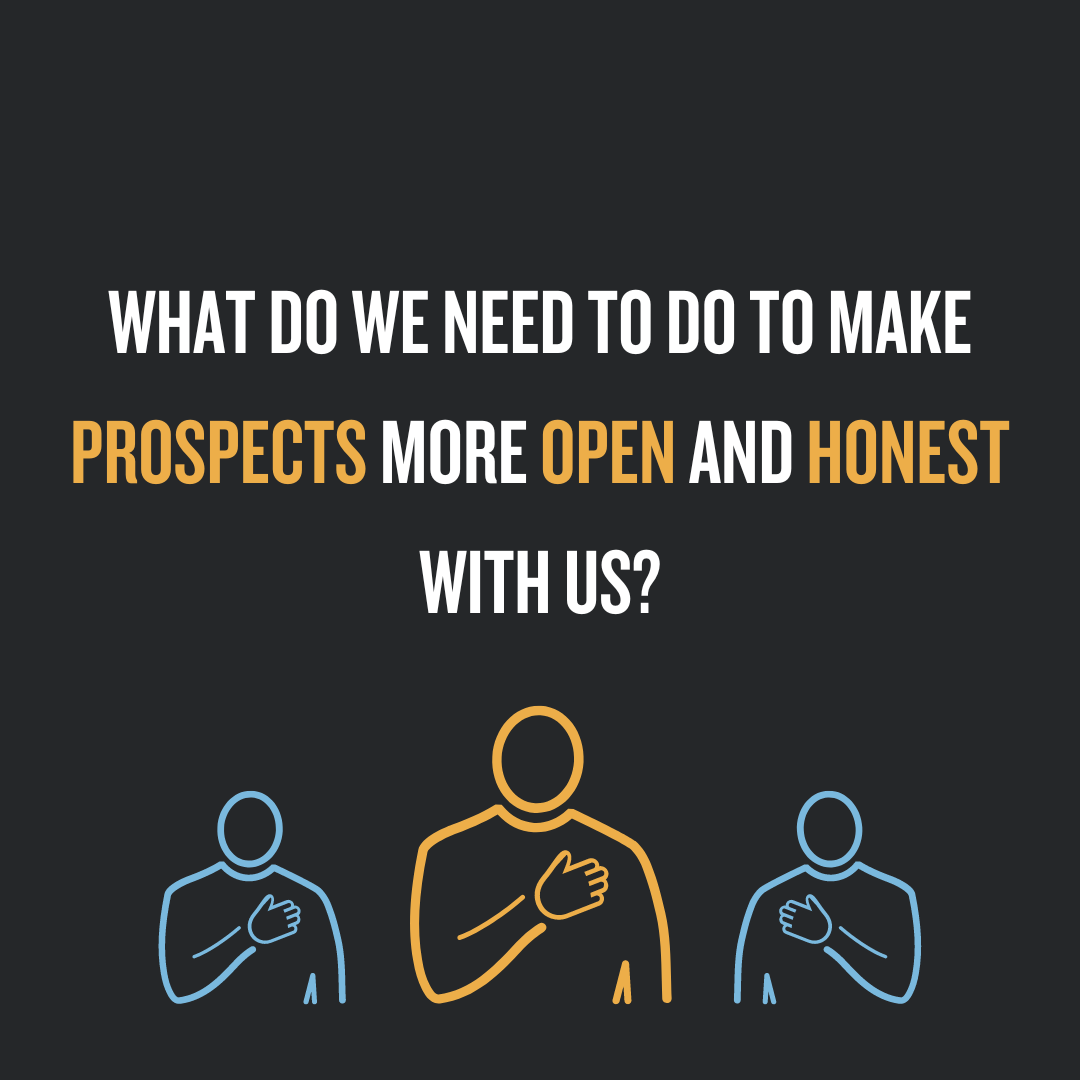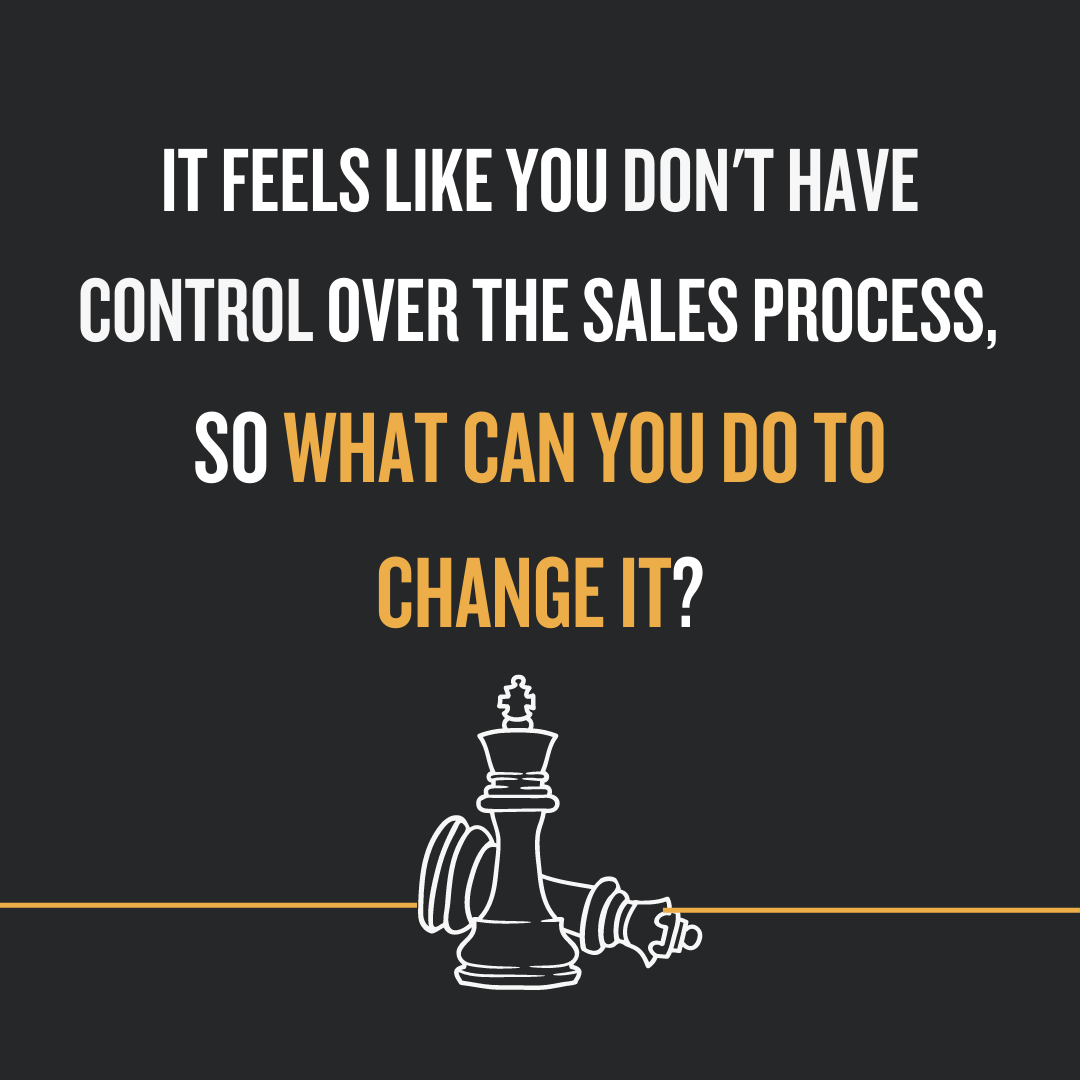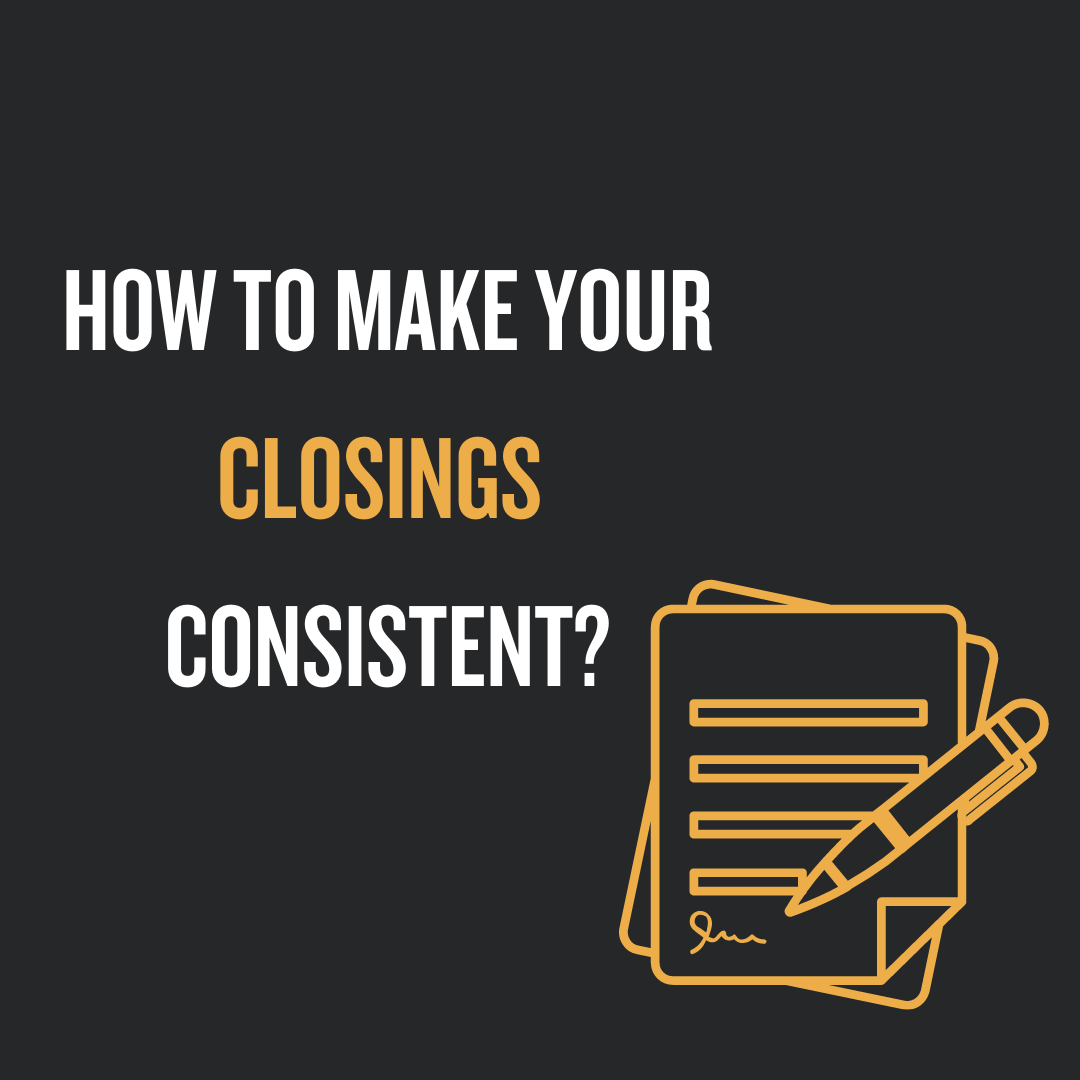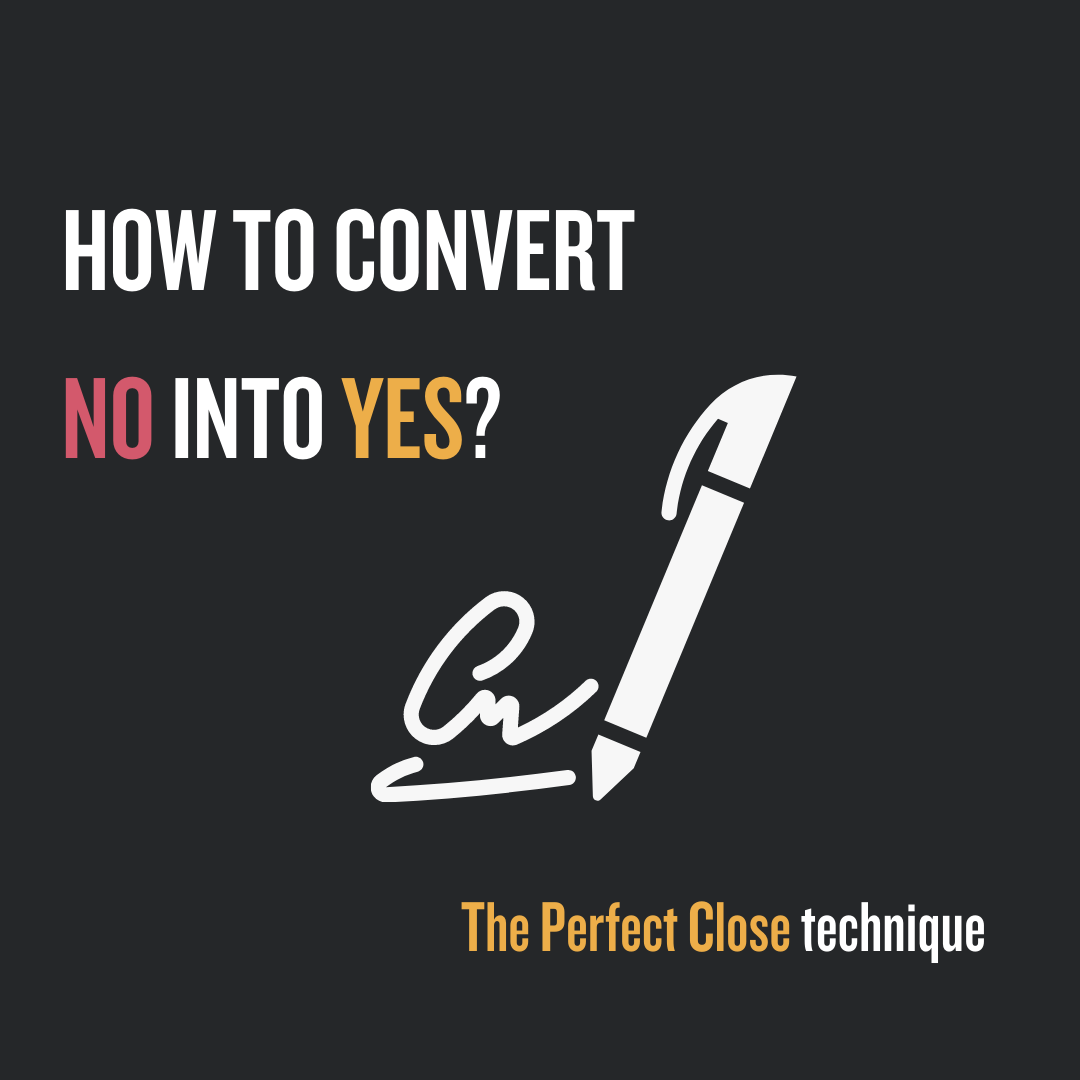Struggle with consistent closing is real. And sometimes even the most skilled salespeople can have deals that drag on for a long time.
In this article, I will cover some advice to make your closing more consistent.
Are you ready? Let’s go.
Closing should be easy (for the prospect).
Before diving deeper into how and why you need to understand one simple thing - closing is all about the prospect’s wants and needs. One of the biggest mistakes salespeople can make is to push their prospects. They don’t listen, and they just push their prospect for a decision.
Even if you have good intentions, this tactic won’t work.
If you keep asking for the sale, it will not help you close the deal. In fact, it might make the buyer less likely to want to buy from you. So, you should stop asking for the sale multiple times during each meeting.
Hear me out, closing, for your prospect, must be easy - that's the ultimate secret of a repetitive close.
The truth is, the best closings are the ones that you can do without thinking. They must be natural, easy, and quick so they don't scare prospects away or seem like sales tactics.
What exactly is closing, though?
Some salespeople see closing as “Doing whatever you have to do to get the customer to sign,” but it's the wrong mindset to go with.
Closing isn’t something you do to “get the customer to sign,” but rather it's how well-respected your product or service truly becomes in light of any challenges faced by potential customers when making their decision on who will provide them solutions to their problem.
Let's look at Neil Rackham's definition of a close: “A close is anything that puts the customer in a position involving some kind of commitment.”
This definition creates the right understanding of what closing really is. Because overall what you want to do is to advance your prospect deeper into your funnel and closer to their decision and all due to their own will. And this brings my point to the main closing facts (proven by research) that every salesperson needs to know.
FACT 1. Closing techniques will help you in losing the deal.
Some people believe that if they say a certain phrase, their client will be persuaded to buy whatever it is they are selling.
Neil Rackham found that salespeople who received training on closing techniques used these techniques more frequently. However, this did not result in increased sales success. In fact, because of the training, the number of sales calls that were successful decreased. Here is the quote:
“Closing [as a technique] turned out to be negatively related to success. After the training, the sellers used more closing techniques—so in one sense the training was effective. However, because fewer calls succeeded, the overall effect of the training was a decrease in sales.”
FACT 2. Each value proposition demands a tailored closing.
Some salespeople think that closing techniques work on all kinds of sales but the reality is a little far away from that.
According to Neil Rackham's study, when the value of what you're selling is small, using closing techniques will speed up the transaction time and increase the number of sales. However, as the value of what you're selling increases, using closing techniques becomes counterproductive and can actually slow down the sale.
Rackham describes the situation like this:
"The psychological effect of pressure seems to be this. If I’m asking you to make a very small decision, then—if I pressure—it’s easier for you to say yes than to have an argument. Consequently, with a small decision, the effect of pressure is positive. But this isn’t so with large decisions. The bigger the decision, the more negatively people generally react to pressure.”
“By forcing the customer into a decision, closing techniques speed the sales transaction.” And that, “Closing techniques may increase the chances of making a sale with low-priced products. With expensive products or services, they reduce the chances of making a sale.”
This is an important thing to know when you are trying to sell something. For example, if the value of what you are selling is lower than $99, you might want to use the Double-Reverse Close. But if your solutions are more expensive than that, using closing techniques will not work and might even make people not want to buy.
FACT 3. Closing techniques can damage the basis of trust.
Sometimes we think that using a technique means we're showing our serious intentions towards the prospect. This is true. If someone doesn't want the house, they won't bother trying to close the sale. This isn't really the issue though.
The real question is how your client sees your use of a closing technique.
Jon Hawes, James Strong, and Bernard Winick researched six closure techniques in a study: The Assumptive Close, Yes Set, Model/Example, Reciprocity, If-Then, and Impending Event.
The study showed that all of the techniques tested damaged trust. Predictably, the most manipulative techniques damaged trust the most.
In his book "The Perfect Close: The Secret To Closing Sales" James M Muir brilliantly states:
"If you want to show your client you want their business—tell them. Or, do something special for them. There are far better ways to show you want the business than insulting them with a closing gambit."
FACT 4. Closing techniques can trigger buyers' remorse.
You may think that clients are happier after they make a decision. This is because they have finished making choices and can now relax and using closing techniques on them is actually helping them.
So, pressuring or manipulating the client into a purchase is actually good for them.
But the truth is that most people are less satisfied with the decisions they make under pressure. This is especially true when it comes to purchasing decisions. If you want to avoid buyer remorse, cancellations, and left-field complaints after the sale then avoid this toxic mindset.
FACT 5. You are assisting buyers in reaching a decision that is in their best interests.
Here, after all of this negative talk about techniques, you may think that you shouldn't do anything for the close and it will close itself. But let me save you from going to extremes and explain.
Studies have shown that you need to make an effort to close the sale in order to be successful. The impact of not making any effort is much worse than the impact of closing techniques. For example, one study showed that asking just one closing question raised the percentage of successful sales from 25% to 61%.
The sad thing is that a large percentage of deals is not lost to competitors, it's lost to no-decision.
Depending on the sector, 20% to 80% of losses are due to no decision, with the average appearing to be 45% to 60%. So, the key message is that you play a part in assisting buyers in reaching a decision that is in their best interests.
Some salespeople will say that their efforts are not paying off. That they do their best and still have zero results. And usually, there are two main reasons why closing efforts fail:
1. Salespeople and professionals do not try hard enough.
2. When they do try, their approach does not work or is counterproductive.
Of these two, managers prefer to see the skill as the main problem because it can usually be fixed with training. But sometimes the problem lies deeper than that.
There are a few reasons why professionals might be reluctant to close business. They might be afraid of being pushy, or they might be worried about being humiliated if something goes wrong. They might also be afraid of not being prepared, or of losing the sale altogether. Whatever the reason, reluctance is usually caused by fear or shame.
If we think about how we talk to our clients, we can avoid being pushy. We can make replies to our questions predictable so that people don't feel embarrassed. We should keep our questions simple and helpful so that we don't need to prepare too much. By using a clever question, we can get useful replies that will
Listen, making money is a wonderful side effect of closing well.
But the truth is, life is more than making money.
People want you to help them make changes so they can be better. They expect you to help them make commitments and achieve their goals, and it’s a noble purpose to do this for them. So, accept the challenge and be their guide through the process.
You are the person that helps your client reach their goals. They will be grateful and thankful for you, crediting both skills and techniques in achieving success but it's really about having an attitude towards selling that makes all this work worthwhile.
For example, The Perfect Close (coined by James Muir) technique relies on your mindset and intent. So let's talk about finding those qualities within yourself.
Why is mindset important for closing?
Well, this is my cue to introduce you to mirror neurons.
In academic definition, mirror neurons are a type of brain cell that respond equally when we perform an action and when we witness someone else perform the same action.
But what is important for us to know is that mirror neurons help us feel what other people feel. We can understand other people's points of view, and we can understand their intentions, too.
And this sub-conscious information is crucial for us and we need to be aware of these distinctions so that we understand the involuntary messages that our prospective clients are receiving from us.
How?
Thanks to psychologist Paul Ekman (who conducted phenomenal research on non-verbal communication back in the 1950s), we can understand the brief, involuntary facial expressions that come from our emotions. And these expressions usually happen in high-stakes situations where people have something to lose or gain.
Micro-expressions are brief, fleeting messages that escape your control. For example, they can be seen when you try to hide how you feel.
It’s worth understanding that your subconscious and autonomic systems are always working. They are reading the body language of other people to understand their intentions and emotions and all this subconsciously gained knowledge turns into a thing called paralanguage.
People can control how they sound when they talk. Most of the time, people express their attitudes on purpose. But sometimes people express their emotions without meaning to. So, even though paralanguage is not as important as visual cues, it is still important to be aware of how we sound when we speak.
And you may ask me, why the hell do we have this long science introduction? It's pretty simple:
Your prospective clients are noticing the way you act and the things you do without realizing it. This forms their overall opinion of you and this opinion, in turn, influences their decision in the future.
You can't control these things, you can't just feel the way you want to feel. And at the same time, your prospect is a walking x-ray (as well as you are) and they can feel your intentions.
And this long introduction brings us to the main point I was trying to emphasize. Yes, you can't control your emotions, BUT you can successfully manipulate them and that's where the right mindset steps in.
With the right mindset, your body will naturally form positive micro-expressions, deliver the ideal tonality, and show the emotions you want your client to empathize with. This will help create trust and rapport.
But what is the “Right Mindset”?
From a psychological perspective, our brain immediately assesses whether we are dealing with an ally or enemy. Because the first step in trusting someone is to figure out if they are capable of following through with what they say.
This, in turn, is also the first step in figuring out if someone is competent.
Here we need to talk more about definitions.
Attributes are qualities that something has. For example, "Her voice has a warm tone," describes an attribute of someone's voice. Traits are general behavior tendencies that a particular attribute produces. For example, "Her warm voice makes her very considerate and approachable."
The warmth attribute displays traits related to how people feel about your intent, how friendly you seem, how helpful you are, how sincere you appear, how trustworthy people think you are, and how moral they believe you to be.
When customers sense that you are only looking out for yourself, they become less inclined to trust your advice or recommendations. As one client put it: “He had such thirsty eyes; I could tell he wasn't really interested in my company."
This caused them not only to refuse but also to become resentful towards this particular individual's efforts on their behalf because there seemed no genuine effort behind his presentation.
That is exactly the type of feeling we are trying to avoid.
It is often hard not to think about what we can get out of interaction when the opportunity is big. We may have good intentions, but it is easy to forget them when we are focused on what we can gain.
There are two determinations that buyers are making each time they meet the salesperson:
1.What is this person’s intent (good or bad)?
2.Does this person have the ability to execute that intention?
There is not the most pleasant truth: When the prospect wants to buy something that is new to them, the sales agent can take advantage of the prospect because the prospect isn't experienced. Let's be honest, it happened to me and it happened to you.
We are vulnerable because we don't know as much as the sales agent does. So the main point here is that we want to make the prospect trust us, we want to show them that our intent is clear and all we want is to help.
How do I get myself into the right mindset?
There are three simple steps you can take before any interaction to adopt the right mindset:
1. Lose the Ego
Having a strong sense of self-esteem is important to feeling competent. However, it's important to be warm and seem like you want what's best for the prospect in a sales situation. That way, the prospect will feel like you're on their side and you're not above them (with all that knowledge that you have)
When you are in a state of ego-driven desires, your body sends out the wrong signals. By losing your ego your body will transmit the right messages and will show your intent in the best way possible.
2. Create Positive Emotion
It's time to use a Positive Recall technique: think of a time when you felt really friendly and helpful. Remember what it felt like to be sincere, trustworthy, and moral. Try to relive that experience.
As well as that you can try The Posture technique. Amy Cuddy and Dana Carney recently discovered that the way you hold your body affects your emotions and hormone levels.
People can improve their hormone response by pretending to feel a certain way. For example, if someone wants to feel more powerful, they can try sitting or standing in power poses. This will increase their testosterone levels, decrease their cortisol levels, and make them more willing to take risks.
3. Enter with the Right Intent
Positive self-talk is a great way to improve your performance in everything from decision-making and strategy formulation all the way down to academics. One thing you should make sure of though, before engaging with someone or talking yourself up so much that it sounds fake - think about how they might feel when hearing those words come out of their mouth later on downstream!
“I’m curious to learn how I can best help these people. I’m thrilled to find out what I can do for them.” These statements (when said genuinely) will cause you to project the right intentions to others.
Remember, warmth is weighted heavier than competence because the potential client is outside of their area of expertise. So it's vital to project the proper mindset.
Bonus tip:
It is important to be warm and sincere when you first meet someone. This is when they will form judgments about your intentions. If your words and body language match, it will make a good impression on them.
There are many ways to let clients know what you can do for them. You need to adjust your message depending on the meeting. Sometimes, it is better to be short and sweet. Just say something along the line:
“What I’ve come to learn after X years in the business is that every client is unique. So our goal is to get you a solution that is exactly what you want. Most of the time we can do that—but not always—and by working together, we can identify all the dimensions
You want to make sure that you are providing the prospect with what they need. And you'll do this by finding a solution that meets their needs exactly. This way, we can move through the process of understanding each other smoothly.


